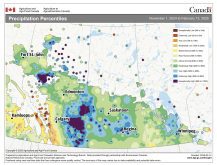WASDE is back, but it didn’t shake the market, indicating that other commodity intelligence was at work in the one-month layoff of American data.
The U.S. government’s World Agricultural Supply and Demand Estimates, often disputed by traders and analysts, are none-the-less a guide to where domestic and international inventories and purchases are taking place. The estimates can also reveal intentions of marketplace players, from farmers through feeders and processors.
After taking January off due to the American government’s partial shutdown, the big report, 40 pages in length for February, as it typically is, offered insights. However, the agricultural markets appear to have anticipated much of what was summarized in the document, such as the world still has too much wheat.
Read Also

USDA’s August corn yield estimates are bearish
The yield estimates for wheat and soybeans were neutral to bullish, but these were largely a sideshow when compared with corn.
Despite information in the WASDE that might have buoyed wheat prices, suggesting Feb. 8 that this year’s winter wheat seeding in the American Plains States was lower than initially reported in December’s release falling to 31.3 million acres, wheat prices remain under pressure. Typically this means that markets will wait for bad-weather news to shift up, or fair weather to step down.
Last week’s extreme cold, which was rough on winter wheat in the American growing region, has been followed by snow and rain, with flooding now an issue, which is further tampering with the seeded fields.
However, the weaker U.S. feed usage in the WASDE showed off its ability to temper a market with demand news and has increased wheat stocks, leaving 35 million more bu. in the system than the previous USDA monthly report.
“There is too much wheat in the world and too much in the United States,” said Arlan Suderman of INTL FC-Stone in his post-WASDE wrap up.
The commodities analyst said the markets had a gut feeling about where the supply and demand was going to go with this report, so they didn’t move that much after its release.
Large inventories and offsetting demands were the story of the report, even when the inventories dropped in the report.
Suderman said soybean supplies remain too high to justify US$9 per bu. prices. He feels the USDA’s estimate of a $8.60 per bu. farmgate price for the 2018-19 crop year is also too high and should likely be in the $8.35 range. But it will be the new crop that will take the bigger plunge, as he estimated producers can look forward to $7.80 if they plant 82 million acres of soybeans this spring and see yields of 49 bu. per acre. That would reflect a three-bu. yield drop over this past year and a seven million acre reduction in plantings.
“If they go ahead and plant 87 million (acres) and get a yield like (2018-19 of 52 bu. per acre), then we will see a $6.35 per bu. price,” he said.
Prices could be further weakened by new crushing capacity coming into production in other locations around the world, as is planned by several companies.
Should American farmers pull back to 79 million acres and yields fall to 49 bu. per acre, then the price could be as high as $8.45.
“Not much good news there,” he said about the world supply of 85 days for soybeans.
Canola and rapeseed futures, ICE and the Paris market, were both down slightly to start the week on Feb. 11.
Corn fared better in the WASDE report, if improved price projections are what is wanted, with actual and projected demand falling, but not as fast as supplies. Ethanol and feed use is projected by USDA to have fallen by 46 million bu., lending some optimism to the crop.
USDA cut its forecast of 2018 production by 206 million bu. to 14.42 billion. Despite the drop, corn futures also trimmed their prices slightly after the report.
Suderman was more bullish about corn, suggesting it has a much better outlook than soybeans or wheat.
“A 42-day supply of corn is similar to six or seven years ago. Ethanol and feed demand is increasing and we could see a 29-day supply. That would get us to $4.85, one dollar more than where we are today,” he said.
USDA’s 42-day global supply is quite a bit larger than he said is present at the moment, with his estimates of ethanol use and exports becoming considerably larger than the government projects before the end of the crop year, potentially pushing corn to about $4.50 per bu., compared to USDA’s price of $3.60.
For next season, Suderman sees the potential of $6.15 per bu. possible, provided producers plant 91 million acres of the crop and harvest a yield similar to this past fall of 176.5 bu. He feels that even if growers plant 95 million acres, pulling back from soybeans, and had a 180 bu. crop, the price could be as low as $4.35, considerably better than current farm prices of $3.50.
Wild cards still remain, however, including China’s tariffs on U.S. farm goods, and the threat of African swine fever in southeastern Asia, said Suderman.
















